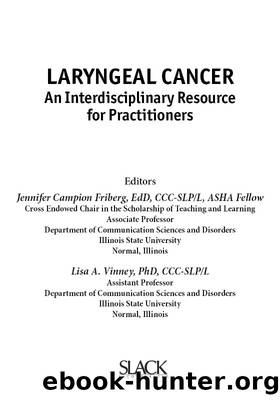Laryngeal Cancer by Friberg Jennifer;Vinney Lisa; & Lisa A. Vinney

Author:Friberg, Jennifer;Vinney, Lisa; & Lisa A. Vinney [FRIBERG, JENNIFER CAMPION]
Language: eng
Format: epub
ISBN: 4717773
Publisher: SLACK, Incorporated
Artificial Electrolarynx Speech
The electronic artificial larynx has a long history in postlaryngectomy rehabilitation (Keith, Shanks, & Doyle, 2005). It is unfortunate that, over the years, the EL has been met with some unwarranted negative bias against its use (Berry, 1978; Doyle, 1994; Duguay, 1978; Gates et al., 1982). However, at the very least, the EL is likely to serve as an important first step in speech rehabilitation after laryngectomy and to be used for at least some communication purposes by more than half of all laryngectomees 2 years after surgery (Meltzner et al., 2005). The EL is an extrinsic method of alaryngeal speech that is designed to provide an electronically powered external voice source. In addition, the EL may be used by a speaker in two different ways. First, and most commonly, the EL can be placed directly on tissues of the neck, the chin, or the cheek. When the EL is activated by the user manually, the EL signal is transferred across that tissue into the vocal tract, where it can be articulated into the sounds of speech. When the EL is used in this manner, it is referred to as a transcervical or neck-type EL. In contrast, the second method of using an EL is achieved by introducing the signal into the oral cavity. Some EL devices are designed to have a small tube attached to the device. Thus, the EL sound source can be transferred through the tube and introduced directly into the oral cavity, where it can then be articulated into the sounds of speech. When this approach is used, it is termed a transoral or mouth-type EL. It is important to note that for some commercial neck-type EL devices, an adapter also may be used to convert such devices for intraoral use. This adapter simply attaches to the portion of the EL that would be applied to the neck and allows a small-diameter oral tube to be inserted into that adapter. Regardless of the method of EL use, instruction by a qualified SLP serves to optimize communication outcomes and the efficiency of this mode of alaryngeal speech (Doyle, 1994, 2005) (Case Study 5-2).
Although there are no published data on the relative proportion of laryngectomees who use either a neck-type or an intraoral EL device for communication purposes, clinical observation suggests that the neck-type EL is used more commonly. Regardless of whether one chooses to use a neck-type or intraoral type of EL, limitations exist, and both approaches entail important clinical considerations. For example, in the early postoperative period, intraoral devices are preferred, because contact with tissues of the neck after surgery should be avoided to reduce discomfort. Similarly, a neck-type EL device may not be effective in those who experience considerable swelling of the tissues of the neck as a result of postsurgical fluid retention (i.e., lymphedema) or in those who have less compliant tissues or fibrosis as a result of the effects of radiotherapy or a combination of these factors. Both of these conditions, as well as factors related to scarring, sensitivity, pain, etc.
Download
This site does not store any files on its server. We only index and link to content provided by other sites. Please contact the content providers to delete copyright contents if any and email us, we'll remove relevant links or contents immediately.
| Administration & Medicine Economics | Allied Health Professions |
| Basic Sciences | Dentistry |
| History | Medical Informatics |
| Medicine | Nursing |
| Pharmacology | Psychology |
| Research | Veterinary Medicine |
Periodization Training for Sports by Tudor Bompa(7922)
Why We Sleep: Unlocking the Power of Sleep and Dreams by Matthew Walker(6361)
Paper Towns by Green John(4800)
The Immortal Life of Henrietta Lacks by Rebecca Skloot(4258)
The Sports Rules Book by Human Kinetics(4079)
Dynamic Alignment Through Imagery by Eric Franklin(3920)
ACSM's Complete Guide to Fitness & Health by ACSM(3825)
Kaplan MCAT Organic Chemistry Review: Created for MCAT 2015 (Kaplan Test Prep) by Kaplan(3802)
Introduction to Kinesiology by Shirl J. Hoffman(3626)
Livewired by David Eagleman(3535)
The River of Consciousness by Oliver Sacks(3418)
The Death of the Heart by Elizabeth Bowen(3342)
Alchemy and Alchemists by C. J. S. Thompson(3296)
Descartes' Error by Antonio Damasio(3166)
Bad Pharma by Ben Goldacre(3098)
The Emperor of All Maladies: A Biography of Cancer by Siddhartha Mukherjee(2930)
The Gene: An Intimate History by Siddhartha Mukherjee(2927)
The Fate of Rome: Climate, Disease, and the End of an Empire (The Princeton History of the Ancient World) by Kyle Harper(2874)
Kaplan MCAT Behavioral Sciences Review: Created for MCAT 2015 (Kaplan Test Prep) by Kaplan(2816)
